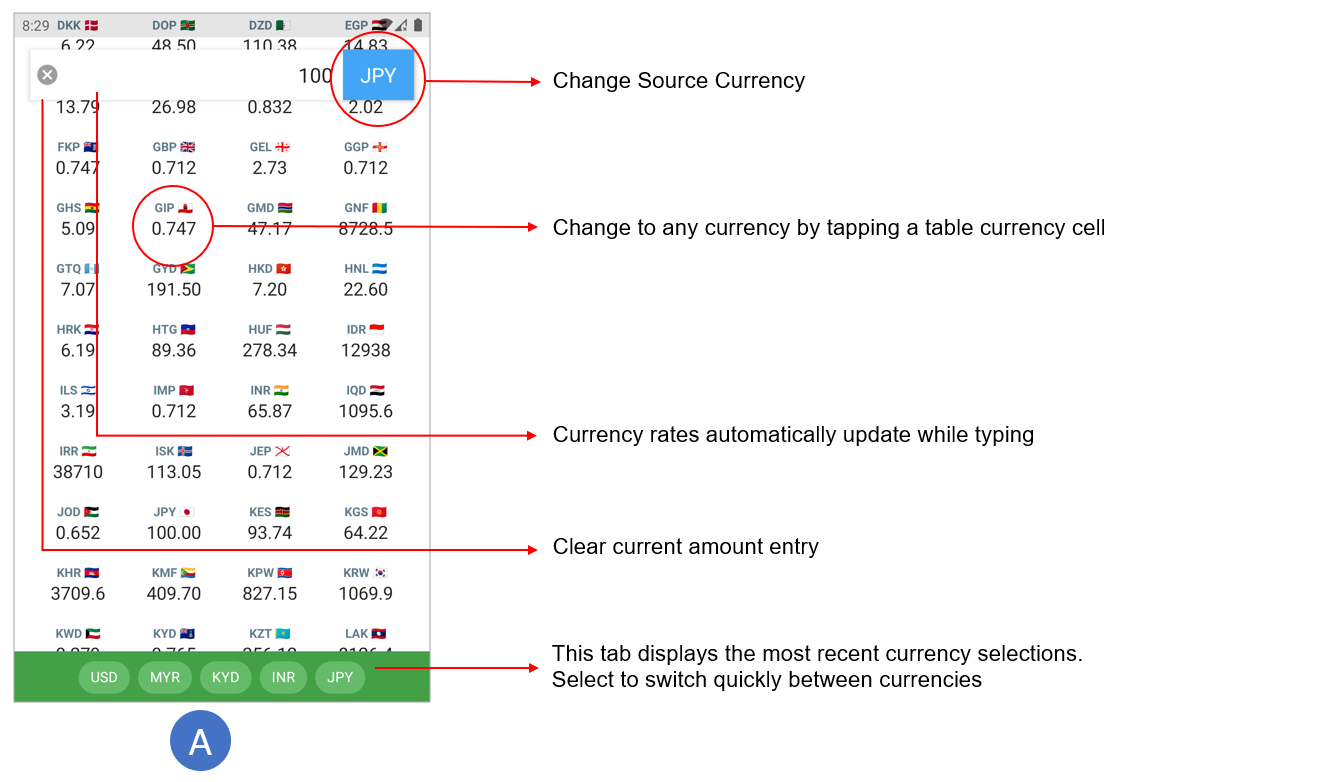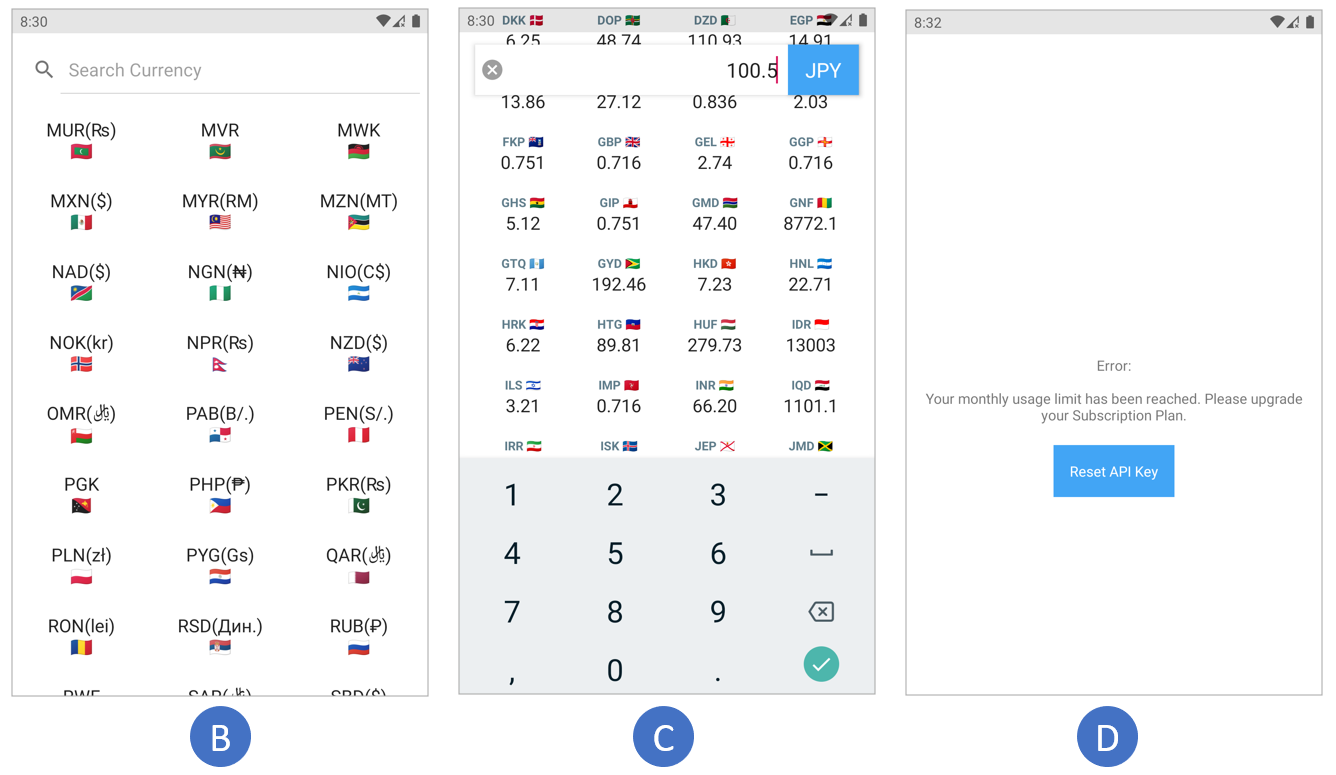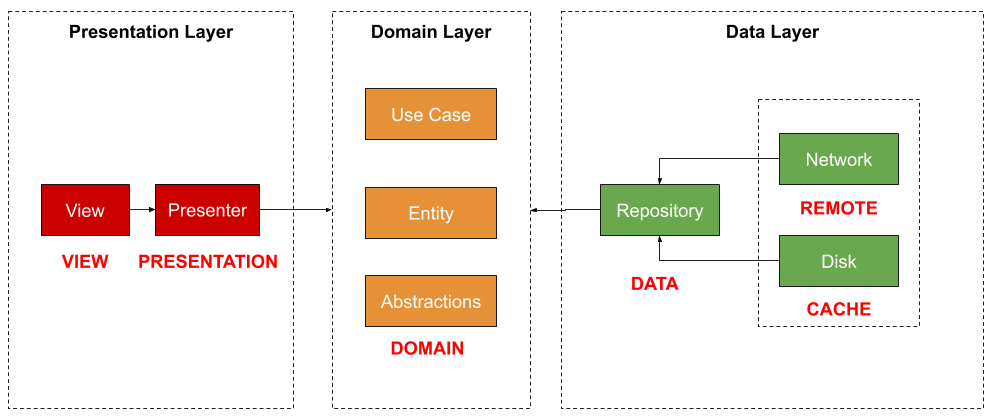Currency Exchange App
A multi-module currency exchange app built on the principles of clean architecture design. Code is available for viewing at https://github.com/jairrab/CurrencyExchangeApp
- Technical Goals
- App Screenshots & Overview
- App Design
- Testing
- Other Key Libraries
- Team Collaboration Compliant
- Key References
Technical Goals
The main objective is to develop it using a modern architecture that is very compliant with a team development setting.
- Adheres to Clean Architecture design principles.
- Maintainable, scalable and flexible (adaptable to future growth, modifications and new requirements).
- Modular code with clear separation of concerns and well defined responsibility for classes, modules/layers. Highly testable.
- Eliminate frictions between teams/individuals working on a project. Promotes accountability in a collaborative way.
- Uses widely recognized libraries to support the implementation of key requirements of the app
App Screenshots & Overview


- Change currency by selecting a cell or clicking the currency button. (A)
- The currency dialog offers a quick search functionality (B)
- The table exchange rates automatically updates while typing on the keypad (C)
- The app design supports an architecture that allows errors to be elegantly displayed to the UI when needed (D). Also, the app design allows (for development purposes) the user to update the CurrencyLayer API key. It has a 250 monthly request limit that can be easily exceeded during testing.
- The app properly supports orientation changes by retaining view properties using
ViewModel. - The app is using CurrencyLayer API for exchange rate information. Note that the free version of the API has many limitations, particularly the source currency cannot be changed from USD. Because of this, and to be able to convert between other currencies, additional calcualtions will need to be performed that involved calculating the rates by going from source currency to USD rate to target currency. This will be covered in more detail the
Datalayer section below.
App Design
The app architecture is organized into several layers, namely the presentation, domain, and the data layers.

- Presentation- contains the
ViewandPresentationmodules of the app. The view module contains the activities and fragments that are coordinated through the Presenter/ViewModel. - Domain-
Domainmodule is at the core of our application, that contains the business logic. It should not depend on how the data will be presented or where the data is coming from, as such, this is the most inner part that has no dependencies to the outer layers. It defines use cases which declare operations that can be performed. - Data- contains the repository implementations, and is also responsible for coordinating data from the the network data source (via the
Remotemodule) and the local storage data source (via theCachemodule).
In this architecture, some operation may take place within each module or adjacent modules- such as view coordination (View → Presentation) or server retrieval/caching (Remote → Data → Cache). It can even pass through all the layers (View → Presentation → Domain → Data → Remote), such as displaying the list of items when starting the app
View Module
This module is responsible for handling the user display components. The architecture goal is to ensure that the view layer is completely unaware of the logic of how the views are being controlled. It’s core responsibility should be managing the display of the view elements. This also makes it relatively easier to swap diferrent view modules or layouts depending on the needs of the business. This module uses the following libraries and approaches:
- Uses a
single activity architectureutilizing aNavHostis used to handle the swapping of Fragment destinations.Navigation Componentlibraries are used to create a navigation graph to declare navigational actions. DataBinding, in conjuction withBindingAdapteris heavily leveraged to bind observable data directly to UI elements in the XML layouts, minimizing boilerplate code in the fragments or activities employing them. Two-way data binding is used on the inputEditTextto listen for changes in text input.ListAdapteris used as theRecyclerViewadapter becuase it works very well withDataBindingand handle changes in adapter values internally.Chipwidgets are used to display recent 5 currency selections, on a FIFO (first in first out) order. AStackcollection is used to save the recent currencies.- Views are coordinated by subscribing to
LivedatainsideViewModelscontained in thePresentaionmodule. Views essentialy reacts to changes in observed data, and are thus this layer is effectively decoupled from the other parts of the program, making it very easy to replace, modify or maintain. Sealed classesare used to manage the state transition between theViewandPresentationmodules.
Presentation Module
This module is responsible for making calls to the data sources, as well as coordinating the LiveData sources that helps coordinates the view elements on the View module. The Presentation module depends on the Domain layer. This module uses the following libraries and approaches:
ViewModel- store and manage UI-related data in a lifecycle conscious way. The ViewModel class allows data to survive configuration changes such as screen rotations. The ViewModels are instantiated using a Dagger module, outside of their owning activities and fragments. A custom ViewModelFactory is used to allow injecting dependencies into ViewModels. On this single activity architecture design, the ViewModels are also responsible for pasing data between fragments.LiveDatais used a lifecycle-aware observable that ensure view component observers are in active lifecycle. Note that only non-mutable LiveData are exposed to observers outside thePresentationmodule, which by design safely prevents outside components from changing the state of the observable.RxJava- used to instantiate observers and pass it to call theDomainuse cases where it would then be subscribed into. TheDomainlayer has no knowledge of it’s observers in this scenario thus keeping it isolated from the rest of the program.- A common issue with LiveData is that its observers are getting re-notified even after orientation changes. To prevent cases we clearly do not want this behaviour, such as an error observer showing the same toast message after rotation, we are using a custom
EventObserverthat checks whether an event has not been handled previously before notifying it’s observers. - In many cases, the data classes (models) used by the
ViewandPresentationlayer slightly varies from the models inside the Domain layer. For this cases, mapper utility classes are used to transform models from one module layer to another.
In general, this architecture is best described as Clean Architecture using MVVM design pattern. Also, the app adopts principles of reactive and functional programming through use of observables and observers and schedulers. For example, the presentation layer waits to be notified by the domain layer when a network call is made. The UI layer waits to be notified by livedata objects to display view changes. Many of this calls has to be performed asynchronously and schedulers helps with thread management, such as using RxJava’s observeOn to tell observers which thread they should run on. My goal was to end up with a more cleaner, readable, and structured code base and this helped a lot.
Domain Module
This module is purely a Kotlin library with NO Android dependencies. The domain calls for subscribing it’s observers into the main UI thread, for this, I created an abstraction for the main thread that will be implemented in the View module (using AndroidSchedulers.mainThread) so that the domain layer can be free of the Android framework. This module uses the following libraries and approaches:
-
This layer contains the various use cases. The domain defines all the rules that the program must comply with. For this, they receive the data provided by the user and perform the necessary operations. For example, a use case for
GetExchangeRatedefines the parameters and outputs for getting exchange rate.With this setup, as the requirements of the app grows and more features are added, it would be easy to add more use cases without affecting other parts of the program. This supports the goals of this app for scalability and flexibility.
RxJava- use to build use case observables and for subscribing it’s observers.- This module defines an abstraction of the data repository (
DomainRepository) that will be iplemented in theDatamodule of the app and injected usingDagger.
Data Module
This module is purely a Kotlin library with NO Android dependencies. This module depends on the Domain and is responsible for the concrete implementation of the DomainRepository. The concrete impplementation is binded using a Dagger module, keeping the Domain isolated.
- This module defines the abstraction for the remote (
RemoteRepository) and cache (CacheRepository) repository, that will be implemented in theRemoteandCachemodule respectively. - This modules defines the data class that is required to be supplied by the
Remoteand theCache. Mapper classes are used to transform the data into domain form (again, keeping the domain independent). - The main library used is RxJava- and it’s sued to construct observable chains that defines the logic of how the data will be obtained from the data sources (
RemoteandCache), including error management when an exception occurs. For instance, the following is a snippet of the code that is used to obtain the exchange rate:
override fun getExchangeRate(
inputCurrency: String,
outputCurrencies: List<String>?
): Observable<ExchangeRate> {
return localRepo.getCachedTimeStamp("USD") //gets cached timestamp
.onErrorReturnItem(0) //cache should return 0 if empty, or when there's error
.map { dataStore.getDataStore(if (timeUtils.isCacheValid(it)) CACHE else REMOTE) }
.flatMap { repo ->
when (inputCurrency == "USD") {
true -> repo.getExchangeRate("USD", outputCurrencies)
.flatMap {
when (repo is CacheDataStore) {
true -> Observable.just(it)
else -> localRepo.saveExchangeRates(it).andThen(Observable.just(it))
}
}
else -> repo.getExchangeRate("USD", outputCurrencies)
.flatMap {
when (repo is CacheDataStore) {
true -> Observable.just(it)
else -> localRepo.saveExchangeRates(it).andThen(Observable.just(it))
}
}
.zipWith(
localRepo.getExchangeRate("USD", listOf(inputCurrency)),
BiFunction { t1, t2 ->
mapper.mapRatesToNonUsdCurrency(
inputCurrency = inputCurrency,
uSdExchangeData = t1,
nonUsdExchangeData = t2
)
})
}
}
.map { mapper.mapToExchangeRate(it) }
}
RxJava Chain Overview
- Checks local repository for latest timestamp. Returns 0 if empty (or error)
- Selects either the cached or remote data source depending on the amount of time since the cached data was saved (30 minutes cache time limit)
- If using remote source, retrieve the data and store it to the cache
- Map the retrieved currency rates to the
Datamodule reuirements - The free
CurrencyLayerAPI only allows for USD as the input source. If the source is other than USD, perform a currency rate conversion by calculating the exchange rate between the source currency and it’s USD rate equivalent.RxJavaBiFunctionis used to take the two parameters, perform calculations and emit the needed exchange rates.
Log Output
- As seen below, the first time the app was run, it detected that cache was more than 30 minutes, and thus retrieving the exchange rate information from the remote server.
I/System.out: ^^ Cache: getting timestamp I/System.out: ^^ Cache data is 26231406.5789 minutes old I/System.out: ^^ Remote: Getting rate for all currencies I/System.out: ^^ Cache: Saving exchange rate - The next time the app was run, it detected that cache was less than 30 minutes, and thus retrieving the exchange rate information from the local cached data source.
I/System.out: ^^ Cache: getting timestamp I/System.out: ^^ Cache data is 0.30261666666666664 minutes old I/System.out: ^^ Cache: Getting rate for all currencies
Remote Module
This module is purely a Kotlin library with NO Android dependencies. This module depends on the data module and is responsible for the concrete implementation of the RemoteRepository. The concrete impplementation is binded using a Dagger module, keeping the Data module independent of this module.
I am using Retrofit in conjuction with OkHttpClient as client service to accessing server data. Retrofit makes it relatively easy to retrieve JSON via a REST based webservice. I’ve added a cache interceptor to the OkHttpClient as a convenient way to cache the information to the local storage for a more responsive app (by limiting network request when data is not that old) and some offline caching.
Since I will need to know if the device has Internet connection, I’ve created a NetworkUtil interface with a hasConnection() function. Checking for device connetion requires access to Application context, and to to keep this module free from Android dependencies, the concrete implementation of NetworkUtil will be provided using Dagger.
Cache Module
This module depends on the data module and is responsible for the concrete implementation of the CacheRepository. The concrete impplementation is binded using a Dagger module, keeping the Data module independent of this module. .
The local data source will be setup and accessed using the Room Library. The Room persistence library provides an abstraction layer over SQLite to allow for more robust database access while harnessing the full power of SQLite. Room is used to save the data retrieved from the server in certain situations. The Data module will orchestrate what data needs to be saved and retrieved, this module is only responsible for implementing how specific local database operations will be done.
GSON library is used to convert the quotes Map information into JSON format and vice versa. The quotes are stored in JSON format into the Room database.
Testing
UI Testing
UI testing of the view layer is performed by using the Espresso testing framework. To ensure that the tests do not fail due to a server fault, I used a similar Dagger setup to allow a mock injection of the DomainRepository. The UI test performs the following operation:
- Launches the app
- Retrieves a preconfigured list of exchange rates information from the mocked repository.
- Scroll to each item on the table
- Check that the item currency matches the expected value
- Check that the item exchange rate matches the expected value
- Test completes
ViewModel Testing
Testing of the ViewModel is done by mocking the Domain response using Mockito. An ArgumentCaptor is used to capture arguments for mocked methods. It is used with Mockito verify() methods to get the arguments passed when any method is called. This way, we can provide additional JUnit assertions for our tests.
Data Repository Testing
DataRepository testing is done by mocking the Remote and Cache data sources. A TestObserver is used to directly run the Observables, where we can then perform JUnit assertions on the responses. For example, to test the Data Module code presented above, the following test code is used:
@Test
fun getExchangeRate() {
whenever(localRepo.getCachedTimeStamp("USD"))
.thenReturn(Observable.just(123))
whenever(timeUtils.isCacheValid(any()))
.thenReturn(false)
val exchangeRateData = makeExchangeRateData()
whenever(remoteRepo.getExchangeRate(any(), eq(null)))
.thenReturn(Observable.just(exchangeRateData))
whenever(localRepo.getExchangeRate(any(), any()))
.thenReturn(Observable.just(exchangeRateData))
whenever(localRepo.saveExchangeRates(any()))
.thenReturn(Completable.complete())
val observer = dataRepository.getExchangeRate("USD", null).test()
val value = observer.values().first()
assertEquals(
value, ExchangeRate(
source = exchangeRateData.source,
quotes = exchangeRateData.quotes,
timestamp = exchangeRateData.timestamp
)
)
}
Room Database Testing
Room database testing is done by creating an in-memory version of the database to make the tests more hermetic. The test check for data insertion and checking back that the data retrieved matches the expected value.
Other Unit Testing
Retrofit client testing is done by mocking the client and making JUnit assertions on the responses. JUnit testing were also done on testing the Mapper classes to ensure that they are mapping data classes correctly.
Other Key Libraries
Dagger 2
The app use Dagger with AndroidInjector module for dependency injection. Dagger setup is done at the View module where it will be responsible for binding a module interfaces to it’s concrete implementation contained in another module. For instance, binding DomainRepository interface to a DataRepository class.
All dependencies are injected into classes. That is, classes should have specific responsibilities and not be responsible nor have any information of how it’s dependencies are created. This decoupled approach also helps improve the testability of the app, and is also a key principle of Clean Architecture.
The modules are organized into the following:
AppModule- Responsible for creating application context dependent objects, such as ToastCacheModule- Responsible for creating the Room Database object, as well as the local database access objectDataModule- Responsible for creating the concrete implementaion of the data repositories defined on the domain layerRemoteModule- Responsible for creating the Retrofit service, as well the remote server access objectUiModule- Responsible for setting up injecting into Android frameworks, such as fragments and activities. Also responsible for binding the domain scheduler into the main UI threadViewModelModule- Responsible for concrete instantiation of ViewModel classes
LeakCanary
LeakCanary was used to detect and anticipate potential memory leaks. LeakCanary’s knowledge of the internals of the Android Framework gives it a unique ability to narrow down the cause of each leak, helping dramatically reduce OutOfMemoryError crashes. The app yielded 0% memory leaks through extensive debug testing.
Kotlin Framework
- Data classes
- Sealed classes
- Kotlin functional programming
- Extension Functions
- KTX extensions
- Coroutines
Dependencies setup
Multiple libraries are used in this app. To mantain consistency and coherence, a single source of library versions is used and is contained in the projects build.gradle file. Also, since this app uses a multi-module architecture, it ensures that when a library updates, all modules using the same library are updated to thelatest version.
ext{
//Android Libraries
appcompat_version = '1.1.0'
ktx_version = '1.1.0'
lifecycle_version = '2.1.0'
viewmodel_version = '2.2.0-alpha05'
room_version = '2.2.0-rc01'
constraint_layout_version = '1.1.3'
cardview_version = '1.0.0'
nav_fragment_version = '2.2.0-alpha03'
//3rd Party Libraries
javax_inject_version = '1'
dagger_version = '2.22.1'
retrofit_version = '2.6.0'
okhttp_version = '3.12.3'
rxandroid_version = '2.1.1'
rxkotlin_version = '2.3.0'
rxjava_version = '2.2.9'
leakcanary_version = '2.0-beta-3'
kotlin_serialization_version = '0.11.1'
//Test Libraries
junit_version = '4.12'
androidx_test_runner_version = '1.2.0'
espresso_version = '3.2.0'
mockito_kotlin_version = '2.1.0'
Team Collaboration Compliant
One of the key goals is to design this app that is compliant with a team development setting. I believe this kind of architecture that is loosely coupled with well defined responsibilities and separation of concerns helps eliminate frictions between members and promotes accountability in a collaborative way. In an agile environment, changing framework or libraries if needed should be relatively easy, because a good architecture is about designing layers and business rules/interfaces so that questions like framework or type of database becomes irrelevant.
Key References
- CurrencLayer: https://currencylayer.com
- Guide to App Architecture: https://developer.android.com/jetpack/docs/guide
- Clean Architecture: https://proandroiddev.com/how-to-implement-a-clean-architecture-on-android-2e5e8c8e81fe
